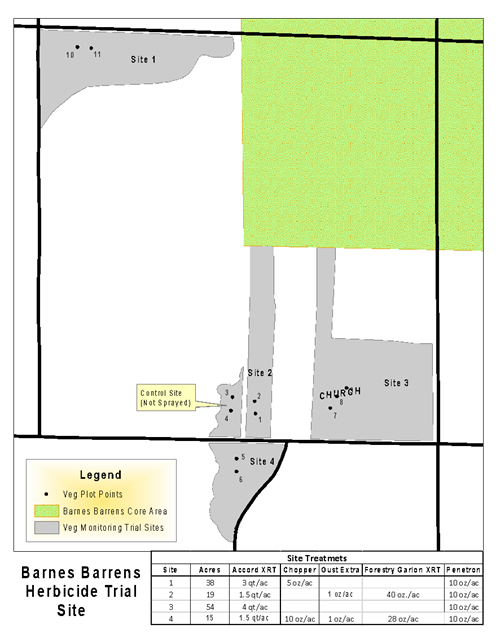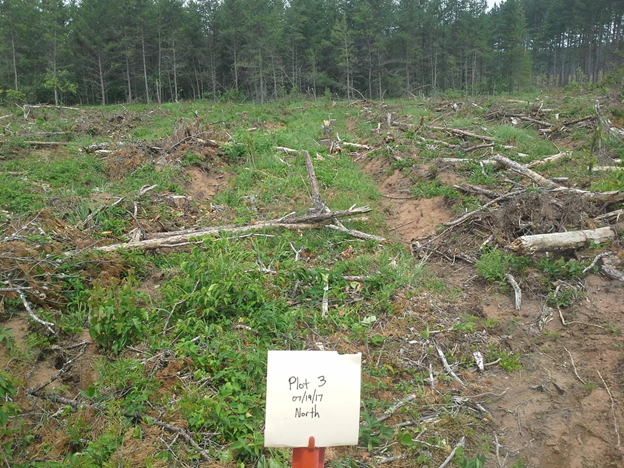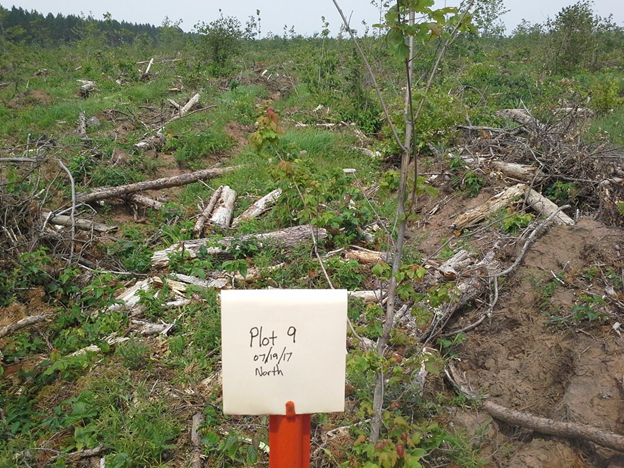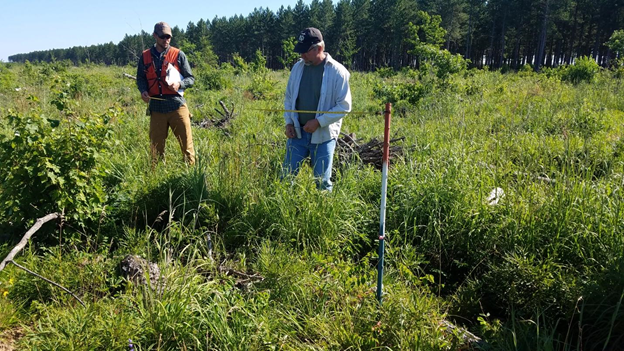Overview
This is a prospective case study describing herbicide treatments designed to control vegetation that competes with jack pine during silvicultural treatments to maintain the pine barrens system. The Barnes Barrens Management Area provides globally rare pine barrens habitat for several imperiled wildlife species that require these open habitat types, including Kirtland’s warbler and sharp-tailed grouse. Sharp-tailed grouse have been shown to rely on relatively young jack pine stands between 0 and 12 years of age.
Although fire was historically the natural disturbance responsible for maintaining these barrens, forest managers have switched to using herbicide to control competition and maintain a more open site. Compared with prescribed fire, herbicide is seen as is more effective, easier to implement, and less costly. The Barnes Barrens Management Area silviculture and management is described in more detail here.
Silviculture Objective(s)
Monitor the effects of different herbicide treatments on vegetation that has the potential to compete with jack pine over time.
Pre-treatment stand description and condition
Stand establishment and management history:
All sites were previously harvested and delineated into separated stands, creating the opportunity to establish permanent vegetation plots for herbicide trails during the regeneration of a new cohort of jack pine. Site prep included disc trenching in 2017 to scarify the seedbed, and in September 2018 the stands were sprayed with varied herbicide treatments (see Figure 1) to control competition. The contractor hired to apply the herbicide was instructed to apply the different mixtures to each site and was required to clean his equipment between stands in order to ensure there was no contamination. All sites will be aerial seeded with jack pine seed in early 2019.

Figure 1: Map of Barnes Barrens Management Area herbicide trial sites and their assigned herbicide treatments.
Pre-treatment growth and stocking:
Below is a summary table showing the changes in vegetation between 2017 and 2018, both years pre-treatment.


Landowner objectives/situation:
Wildlife biologists collaborating with Bayfield County foresters were concerned that site preparation herbicide treatments may be too aggressive and could negatively impact native forbs that sharp-tailed grouse use for forage. This trial is a way to observe the effects of different herbicide mixtures and concentrations over time, with the goal of striking a balance between efficient site prep and mitigating negative impacts on forbs.
Silviculture Prescription
The general silvicultural strategies employed in the BBMA are described in the Silviculture Library case study entitled “Barnes Barrens Management Area (Bayfield Cty, WI).”
This herbicide trial included the following treatments:
Site 1, 38 ac: Accord XRT, 3 qt/ac, Chopper (5 oz/ac), and Penetron 10 oz/ac.
Site 2, 19 ac: Accord XRT, 1.5 qt/ac, Oust Extra (1 oz/ac), Forestry Garlon XRT (40 oz/ac), and Penetron 10 oz/ac.
Site 3, 54 ac: Accord XRT, 4 qt/ac and Penetron 10 oz/ac.
Site 4, 15 ac: Accord XRT, 1.5 qt/ac, Chopper (10 oz/ac), Oust Extra (1 oz/ac), Forestry Garlon XRT (28 oz/ac), and Penetron 10 oz/ac.
Control site: No herbicide application
What actually happened during the treatment
In 2017, 11 permanent vegetation plots were created within the five stands in Zone 1 of Barnes Barrens that will be regenerated with jack pine in 2019. A pre-treatment inventory of herbaceous and woody plant species was done in July 2017 to establish baseline vegetation data. Presence and relative abundance (% cover) of each species was recorded. Two plots, located in a site that was not sprayed at all will serve as a control. All plots were surveyed again in July 2018 prior to herbicide treatment in September. Plot establishment and herbicide treatments were executed as planned.

Figure 2: one of the control plots in 2017, post disc-trenching.

Figure 3: One of treatment plots in 2017, post disc trenching.
Post-treatment assessment
Since an inventory of these sites hasn’t been done since herbicide treatment, the impacts of these treatments have yet to be determined. We will update this case study once those post-treatment results are available.
Plans for future treatments
Plots will be monitored annually for at least 5 years beginning in 2019 to assess the long-term impacts of the different treatments.
Costs and economic considerations
Disc trenching cost $62.00/acre.
Herbicide application cost $69.50/acre.
Other notes
This case study was developed with support from the United States Department of Agriculture's National Institute for Food and Agriculture (USDA-NIFA), Renewable Resources Extension Act (RREA). Project #MIN-44-E02, principal investigator Eli Sagor, University of Minnesota.
Summary / lessons learned / additional thoughts
Barnes Barrens Management Area is still in the early phases of establishment and the results of the trial are yet to be seen. Although climate change implications are not directly considered in this study, it is always part of discussion in forest management and the plan is open to modifications if necessary.
